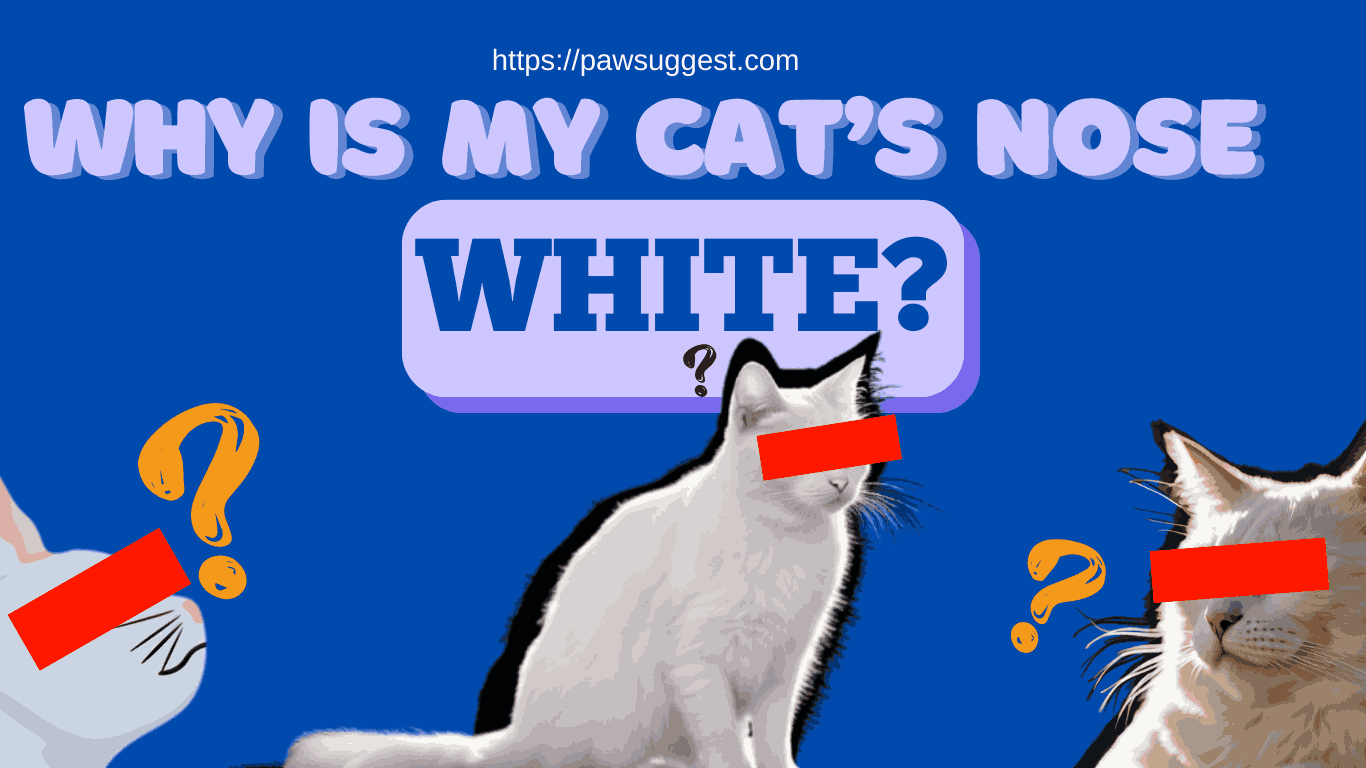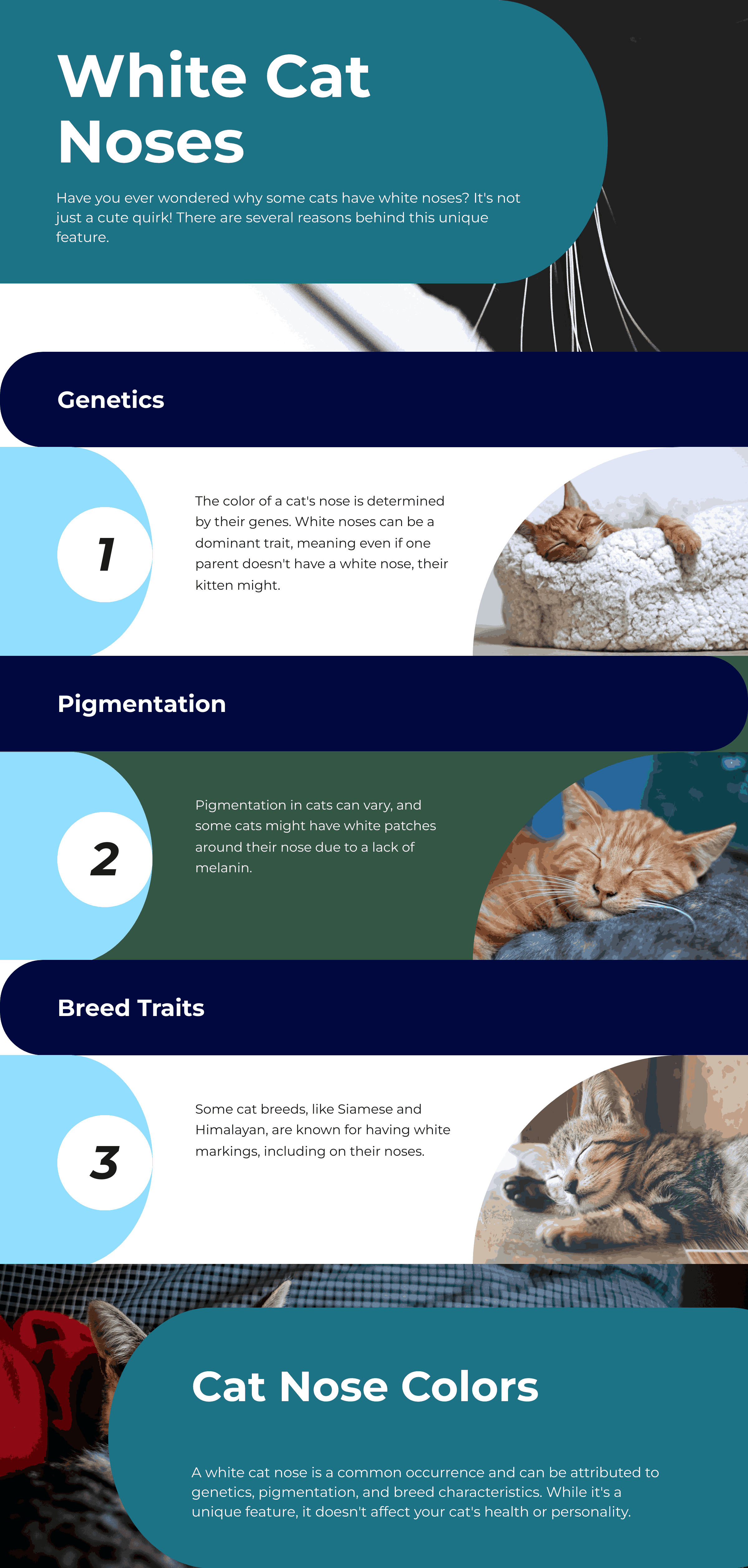Cats come in a variety of colors and patterns, and their noses can be black, pink, or white. If your cat’s nose has suddenly turned white or changed color, it may raise some concerns. Why does this happen, and should you worry?
The color of a cat’s nose can be influenced by various factors. If it’s always been pale, it’s likely just part of their natural coloration. However, if it becomes paler over time, it could point to something more significant. This can be due to temperature, mood, or even medical issues.
From experience, a white nose can sometimes be normal, but sudden changes warrant a visit to the veterinarian to ensure your cat’s health is in good hands.
Why Is My Cat’s Nose White?
Understanding Your Cat’s Nose Color: What’s Normal and What to Expect!
A cat’s nose can come in various colors like pink, black, or spotted. Sometimes, your cat’s nose may turn white. This can happen for many reasons, and knowing the changes can give insights into their overall health. While it’s normal for a cat’s nose to change with age, sudden shifts might point to an underlying health issue.
I’ve noticed my cat’s nose color change in colder months. Temperature changes, emotions, or health conditions can cause this. Domestic shorthairs may have pink noses that darken as they age, but if it suddenly turns white, watch for other symptoms—it might signal a sudden emotional shift or health issue.
Regular vet check-ups are essential. A vet can tell if your cat’s nose color is typical for their breed. For instance, Siamese cats usually have dark noses, while domestic shorthairs often have pink ones. Keep an eye on unusual changes, as they can sometimes point to serious problems.
Reasons Why Your Cat Nose is White
Anemia
One of the primary causes of a white nose in cats is anemia, which is a result of the loss of red blood cells. This condition can be linked to bleeding disorders, malnutrition, bone marrow disorders, or kidney disease. When your cat’s body doesn’t produce enough red blood cells, the nose may turn pale or white. This is usually accompanied by other symptoms like severe fatigue, weakness, and pale gums. It’s essential to consult a vet to diagnose the underlying cause and start treatment to improve your cat’s overall health.
Dehydration
Another common reason for a white nose dehydration in cats. If your cat isn’t consuming enough fluids, especially during warmer weather or after bouts of illness, their body may become severely dehydrated. This leads to a pale or white nose due to reduced blood circulation. Mild to moderate dehydration may cause only slight changes, but in more severe cases, your cat may require IV fluids from a vet to help rehydrate and restore their health.
Hypothermia or Frostbite
Hypothermia or frostbite can also cause a white nose, especially in cold environments. When a cat’s temperature drops too low, the blood vessels in the nose constrict, leading to a paler appearance. Prolonged exposure to cold elements can cause frostbite, where the nose might turn red, blue, or even gray before it becomes white. This is an emergency situation, and your cat should be brought to a vet immediately for treatment.
Skin Cancer
Sometimes, a white nose can be a sign of skin cancer, particularly in cats with paler-colored skin. Overexposure to the sun can lead to serious health issues like melanoma or squamous cell carcinomas, which can manifest as changes in the nose’s color. If you notice any abnormal growth or color changes around the nose, it’s crucial to have your cat checked by a veterinarian to rule out cancer and ensure proper treatment.
Diabetes
Cats suffering from diabetes may also show signs of a pale or white nose. This is because diabetic cats often experience dehydration due to excessive thirst and frequent urination. If you notice these signs, along with weight loss or lethargy, it could indicate that your cat’s diabetic condition is not well managed. A vet can perform blood and urine tests to assess the situation and adjust your cat’s treatment plan.
Feline Leukemia
Feline leukemia virus (FeLV) is a serious and often fatal illness that can cause a cat’s nose to turn white due to anemia. Cats with FeLV are prone to bleeding, and their red blood cells are often affected, making them more susceptible to various infections. If you suspect feline leukemia, it’s important to seek advice from your vet, especially if your cat isn’t up to date on its vaccinations.
Trauma or Injury
A white nose can also result from trauma or injury to the nose. Accidents such as a collision, fight, or impact can cause damage to the tissue, leading to depigmentation. If the nose has turned white after an injury, it’s important to have your cat seen by a veterinarian for an examination to assess the extent of the damage. Moreover, cat injury or trauma can lead to another fatal issue post pregnancy which are inverted nipples.
Vitiligo
In some cases, a white nose may be caused by vitiligo, a condition where the skin loses pigment. As cats age, especially older felines, their immune system may attack pigment cells, causing depigmentation of the nose and other areas. While vitiligo is mostly a cosmetic concern, it’s important to monitor your cat’s overall health, as it can sometimes be linked to other autoimmune issues. Regular veterinary check-ups can help manage the condition.
Allergies or Skin Infections
Allergies or skin infections, like ringworm or dermatitis, can cause depigmentation around a cat’s nose. If your cat is suffering from itchy, inflamed, or scratched areas near the nose, it may result in a white appearance as the color fades. In such cases, a veterinary diagnosis is crucial to treat the underlying issue and prevent further discomfort.
Specific Reasons for Cat Nose Turning White from Pink
When your cat’s nose turns from pink to white, it can be linked to changes in blood flow. In cold conditions, the blood vessels in the nose may constrict to preserve body heat, causing the nose to lose its pink color. This is quite common, especially when temperatures drop.
- Anemia is another possible reason. This condition causes a drop in red blood cells, making the nose appear paler. It can also result from cardiovascular issues or shock.
- Emotional changes like stress or excitement can temporarily increase heart rate and blood flow, making the nose seem pinker, while a relaxed state might lead to a paler white nose.
- Nutritional deficiencies affecting blood circulation and pigmentation can alter the nose color, often linked to an unbalanced diet lacking essential nutrients.
- Lastly, allergies or irritants in the environment can cause inflammation, leading to noticeable changes in the nose’s coloration.
When to Worry and When to Call the Vet for White Nose of Your Cat?
A white nose in your cat can be harmless or signal a serious health issue. If the change is sudden or accompanied by symptoms like sneezing, coughing, vomiting, or diarrhea, contact your vet immediately. Changes in behavior, such as hiding or lethargy, also suggest something could be wrong.
Prolonged or worsening symptoms require a vet’s evaluation, as conditions like cancer or autoimmune disorders may be involved. Regular vet checkups and close monitoring of your cat’s health will help catch problems early and ensure proper treatment. Always consult your vet about any major changes in your cat’s health.
In a nutshell
A cat’s nose can turn white due to several factors, such as pigmentation, environmental conditions, or health issues. While sometimes normal, it’s crucial to monitor for symptoms or behavioral changes. Regular check-ups with a veterinarian can catch any underlying issues early and keep your feline healthy.
If the white nose persists, it could signal a serious health problem. Cats’ noses are sensitive to their environment and internal changes, so prolonged color changes should be discussed with a veterinarian for a proper diagnosis.
FAQs
Why does my cat’s nose go white?
A white nose in your cat might be a typical sign of anemia, where the nose and gums appear pale. While a pale nose can happen temporarily due to cold weather, if it remains consistently pale, it’s important to have your cat checked by a vet. They will perform an examination and blood tests to confirm if anemia is the cause and to identify any underlying issues.
What does the color of a cat’s nose mean?
A cat’s nose color directly matches their fur color. Black cats have black noses, white cats have pink noses, orange cats have orange noses, and gray cats have gray noses. If your cat has a multicolored fur, their nose might also be multicolored, but a white nose can be normal based on their fur.
What does an unhealthy cat’s nose look like?
The color of a cat’s nose is directly related to their fur color. Black cats have black noses, white cats have pink noses, orange cats have orange noses, and gray cats have gray noses. If your cat has multicolored fur, their nose might also be multicolored.
Why does my cat have white inside her nose?
If you see white inside your cat’s nose, it could be due to dried mucus or an unknown secretion. White color might not always be a bad sign, but if there’s leaking or other symptoms, it’s a good idea to check with your vet to ensure it’s not a health issue.





